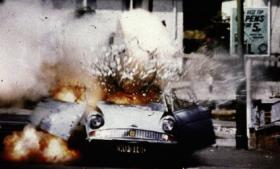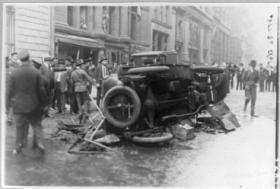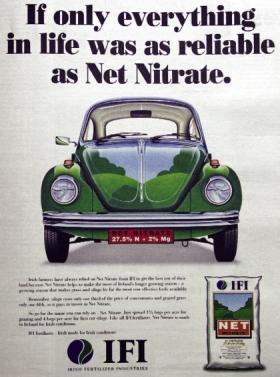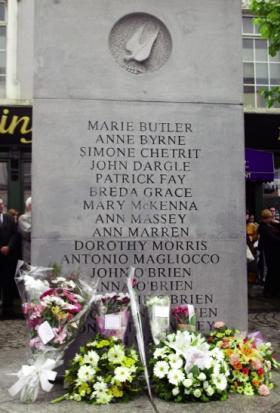TV Eye
Published in 20th Century Social Perspectives, 20th-century / Contemporary History, General, Issue 5 (Sep/Oct 2008), Reviews, Volume 16
A car bomb explodes in Belfast.
Car bomber
Many Rivers Films
27 July and 3 August 2008, Channel 4
by John Gibney
One of the various complaints levelled against Neil Jordan’s Michael Collins (1996) on its release related to the incongruous depiction of a car bomb attack in Dublin Castle. Given that no such attack ever happened in Ireland in 1920–1, the scene could be interpreted as a clumsy attempt to force a parallel with the present; the fact that the intended victims of the car bomb were RIC men from Belfast served to strengthen this case. But the depiction of such an event in the first place was a testament to the extent to which the car bomb had become an iconic image of republican paramilitary violence.
The actual event credited with being the progenitor of the modern car bomb occurred in the same era in which Michael Collins was set. On 16 September 1920 a horse-drawn wagon packed with explosives and shrapnel exploded outside the squat Wall Street headquarters of the J. P. Morgan & Co. bank. The explosion killed 38 people and the scars remain visible on the Morgan building to this day. No-one was convicted for the attack, but the chief suspect was an Italian anarchist, Mario Buda, who was assumed to have carried it out in order to force the release of the anarchists Nicola Sacco and Bartolomeo Vanzetti, whose eventual execution for armed robbery and murder would be regarded as a notorious miscarriage of justice. Whatever about his bequest to posterity, Buda lent his name to a recent history of the car bomb by the American sociologist Mike Davis, on which this two-part documentary was based. Directed by Kevin Toolis, himself the author of a well-received book on the Provisional IRA, it was presented by the former CIA officer Robert Baer, whose career provided much of the inspiration for the film Syriana.

The world’s first ‘car’ bomb? The attack on J. P. Morgan & Co., Wall Street, 16 September 1920.
The purpose of the documentary was to explain ‘how the century of the car turned into the century of the car bomb’.
It began on a personal note, with Baer’s own recollections of the massive 1983 truck bomb attacks on both the US embassy and US Marine barracks in Beirut that, together, left almost 300 dead. It then progressed through some of the various conflicts in which the car bomb took a starring role: the war surrounding the formation of Israel in 1948; the seemingly eternal conflict between the Mafia and the Italian state; the IRA’s bombing campaigns, both in Northern Ireland and in Britain; and isolated attacks on US soil, such as a 1970 car bomb attack on an army building in Madison, Wisconsin, in protest at the Vietnam war, the 1993 World Trade Centre bombing, and the notorious Oklahoma bombing.
The actual purpose of all of this was unclear, however. The documentary was flagged as a history of the car bomb, but in technical terms that seems a fairly straightforward tale to tell. What can be said about it? Buda (if it was him) used a horse and wagon to carry a large home-made bomb; using a car or truck to do the same is just a reflection of changing technology. Equally, the car bomb has a particular relevance to urban environments. But what does this actually tell us? What was most striking about it was the documentary’s complete lack of engagement with the politics that underpin car bomb attacks, or indeed the use of any other

Farmyards cannot be decommissioned. An unfortunate use of imagery in this ad for Net Nitrate fertiliser.
weapon. After all, the car bomb could be an explicitly political weapon, in that the threat it seemed to pose could be as important as the devastation it could wreak. From an Irish perspective, a number of questions came to mind. Did IRA bombs in London really force the British to the negotiating table? Did another car bomb in Omagh in 1998 inadvertently end the ‘armed struggle’? The early stages of the peace process were marked by ongoing wrangling about the decommissioning of paramilitary weapons. But if such a key weapon as the IRA’s car bombs were made of little more than agricultural fertiliser, than surely more important questions relate to the reasons why men and women will construct and deliver such devices, and not only in Ireland. Farmyards cannot be decommissioned, as was seen to brutal effect in the 1996 Canary Wharf bombing that ended the first IRA ceasefire. After all, given that Timothy McVeigh carried out the Oklahoma bombing for less than $800, the technicalities are surely of less relevance than the motives that underpin them (and given that Baer claimed to have been taught to make car bombs by the CIA, it would have been interesting to pursue this).
There were limited attempts to address such questions, and some of the interviews with former car bombers made for compelling viewing. Baer, utilising an interrogative style, spoke to both former Jewish paramilitaries, who had used car bombs against Palestinian civilians, and their Palestinian counterparts, who had responded in kind. In Ireland he interviewed IRA informer Seán O’Callaghan, amongst others. What all seemed to have in common, irrespective of the conflict in which they were embroiled, was a self-serving inclination to claim that they had never deliberately targeted civilians. Many would beg to differ, though other republicans interviewed expressed their regret for events such as the mass car bombing of Belfast on Bloody Friday in 1972. Surprisingly, for a documentary that devoted considerable time to Ireland, there was no mention of atrocities such as the Dublin and Monaghan bombings, or, in an extraordinary omission, the Omagh bombing.
What makes the car bomb special enough to warrant a documentary to itself? It is undoubtedly a weapon of terror, but many weapons are.

Surprisingly, there was no mention of the 1974 Dublin and Monaghan bombings. The monument to the Dublin victims on Talbot Street. (An Phoblacht)
Rather than attempting to provide a coherent analysis of the role of the car bomb in the conflicts in which it was used, this programme tended to rely on occasionally breathless assertions about its relevance: in a world awash with nuclear weapons, is the car bomb really a ‘decisive weapon of conflict’? Is it fair to say that ‘the decisive weapon of our time is the car bomb’? Without any coherent argument, and despite some admittedly striking footage, the repetitive nature of the programme ultimately made for tiresome viewing. The documentary ended with a shift to the events of 9/11 (depicted, not unreasonably, as an inevitable step up from the car bomb) and the subsequent US occupation of Iraq. In doing so it sought to pose the question of whether car bombings could ever be stopped. Considering that this disappointing and ultimately flimsy documentary gave little consideration as to how and why car bombings actually start, an answer to that question lay far beyond its scope.
John Gibney is an IRCHSS Government of Ireland fellow at the Moore Institute for Research in the Humanities and Social Studies, NUI Galway.
















